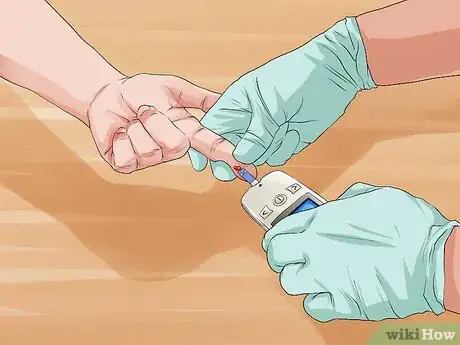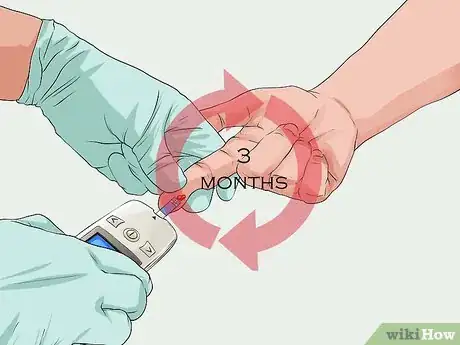This article was medically reviewed by Erik Kramer, DO, MPH. Dr. Erik Kramer is a Board-Certified Primary Care Physician at the University of Colorado. With over 15 years of experience, his clinical interests include obesity and weight management, diabetes care, and preventive care, as well as embracing a holistic approach to primary care. He received his Doctorate in Osteopathic Medicine (D.O.) from the Touro University Nevada College of Osteopathic Medicine and completed his residency at Central Maine Medical Center. Dr. Kramer is a Diplomate of the American Board of Obesity Medicine.
There are 12 references cited in this article, which can be found at the bottom of the page.
wikiHow marks an article as reader-approved once it receives enough positive feedback. This article received 12 testimonials and 85% of readers who voted found it helpful, earning it our reader-approved status.
This article has been viewed 913,254 times.
If you believe that you may have diabetes, consult a medical professional immediately. Type 1 diabetes is when the islet cells of your pancreas can no longer produce insulin; it is a type of autoimmune disease that makes them no longer functional.[1] Type 2 diabetes is more lifestyle-related (relating to lack of exercise and consuming too much sugar).[2] It is important to know the signs and symptoms of diabetes, as well as to understand how it is diagnosed, in order to be treated as soon as possible if you do have the condition.
Steps
Recognizing Signs and Symptoms of Diabetes
-
1Be aware of the following signs and symptoms. If you have 2 or more on the list below, it is best to see your doctor for further evaluation. Common signs and symptoms of both Type 1 and Type 2 diabetes include:[3]
- Excessive thirst
- Excessive hunger
- Blurry vision
- Frequent urination (you wake 3 or more times in the night to urinate)
- Fatigue (particularly after eating)
- Feeling irritable
- Wounds that don't heal or heal slowly
-
2Take note of your lifestyle choices. People who live a sedentary life (with little to no exercise) are at a heightened risk of Type 2 diabetes. People who are overweight or obese, or who eat more sweets and refined carbohydrates than is ideal, are also at significantly higher risk of developing Type 2 diabetes.[4]
- Note that Type 2 diabetes is acquired in one's life, most often related to poor lifestyle choices, versus Type 1 diabetes which is a condition that most often presents in childhood in which the pancreas simply cannot make use of insulin due to a lack of beta cells.
Advertisement -
3See your doctor if you suspect diabetes. The only way to truly confirm whether or not you have diabetes is to see your doctor for diagnostic testing (in the form of blood tests). The numbers that come back on your blood tests will help to classify you as "normal," "pre-diabetic" (meaning you are at very high risk of soon developing diabetes if you do not make some dramatic lifestyle changes), or "diabetic".[5]
- It is best to know sooner rather than later whether or not you have the disease, because if you do, prompt treatment is key.
- The damage that results to your body from diabetes is mostly long-term damage caused by "uncontrolled blood sugars." What this means is that, if you receive treatment that helps to control your blood sugars, you can avert or at least delay many of the long-term health consequences of diabetes. It is for this reason that prompt diagnosis and treatment are key.
Undergoing Diagnostic Tests for Diabetes
-
1Get tested by a physician. Your primary care physician can perform 2 different tests to check your blood glucose levels. Normally, a fasting blood test is used to check for diabetes, but a urine test can also be performed.[6]
- Normal blood glucose levels are between 70 and 100.
- If you're borderline diabetic ("pre-diabetic"), your levels will be between 100 and 125.
- If your levels are above 126, you're considered diabetic. A non-fasting or random blood glucose level of 200 or above can also be a sign of diabetes.
-
2Get your HbA1c (hemoglobin A1c) levels measured. This is a newer test that is being used by some doctors for diabetes. It looks at the hemoglobin (a protein) in your red blood cells and measures how much sugar is attached. The higher the value, the more sugar is attached, which directly correlates to your risk of having diabetes. (After all, diabetes is the heightened prevalence of sugar in the bloodstream.)[7]
- The normal correlation between HbA1c and average blood sugar levels is as follows. An HbA1c of 6 equates to a blood glucose level of 135. An HbA1c of 7 = 170, an HbA1c of 8 = 205, an HbA1c of 9 = 240, an HbA1c of 10 = 275, an HbA1c of 11 = 301, and an HbA1c of 12 = 345.
- In most labs, the normal range for HbA1c is between 4.0-5.9%. In poorly controlled diabetes, it is 8.0% or above, and in well-controlled patients it is less than 7.0%.
- The benefit of measuring HbA1c is that it gives a more reasonable view of what's happening over the course of time. It reflects your average sugar levels over the past 3 months, rather than a simple glucose test which is a one-time measurement of your sugar levels.
- Keep in mind that HbA1c tests aren’t a perfect diagnostic tool for diabetes. Some conditions, like iron deficiency anemia and chronic blood loss, can cause these tests to give misleading results.[8]
-
3Talk to your doctor about how to treat your diabetes. To treat diabetes, you may need to take insulin injections or pills daily, and you will be asked to watch your diet and to exercise.[9]
- Sometimes, in more mild cases of Type 2 diabetes, the only thing needed is diet and exercise. Sufficient lifestyle changes can actually reverse diabetes and put you back into the "normal" range for your blood sugars.[10] Talk about some great motivation to make changes!
- You will be asked to cut back on sugars and carbohydrates, and to exercise for about 30 minutes a day. Your individual needs may vary, but in general, women should eat no more than 45-60 g of carbs per meal, and men should stay in the 60-75 g range.[11] If you follow through with these changes, you will likely see a noticeable reduction in your blood sugar levels.
- Type 1 diabetes, on the other hand, will always require insulin injections because it is an autoimmune disease where the body fails to produce insulin.[12]
- It is extremely important to properly treat diabetes. Note that, if left untreated, the elevated blood sugars from diabetes can lead to more serious health issues, such as nerve damage (neuropathy), kidney damage or failure, blindness, and severe circulation problems resulting in difficult-to-treat infections that can progress into gangrene necessitating amputation (particularly in the lower extremities).[13]
-
4Seek follow-up tests as recommended by your doctor. It is important to get repeat blood tests every 3-6 months or so for people who fall into the "pre-diabetic" or "diabetic" range. The reason for this is to monitor either improvement of the condition (for those who make positive lifestyle changes), or worsening of the condition.[14]
- Repeat blood tests also help your physician to make decisions about insulin doses and medication doses. Your doctor will be trying to "target" your blood sugars to be within a particular range, so having the numerical values from repeat blood tests is key.
- It can also provide motivation for you to exercise more, and to make positive changes to your diet, knowing that you may very well see tangible results on your next blood test!
- If you fall in the pre-diabetic range or if your diabetes is well controlled, you may only need tests every 6 months. If you have poorly controlled diabetes, your doctor may recommend testing every 3-4 months.
Expert Q&A
-
QuestionHow can I tell if I have diabetes?
 Chris M. Matsko, MDDr. Chris M. Matsko is a retired physician based in Pittsburgh, Pennsylvania. With over 25 years of medical research experience, Dr. Matsko was awarded the Pittsburgh Cornell University Leadership Award for Excellence. He holds a BS in Nutritional Science from Cornell University and an MD from the Temple University School of Medicine in 2007. Dr. Matsko earned a Research Writing Certification from the American Medical Writers Association (AMWA) in 2016 and a Medical Writing & Editing Certification from the University of Chicago in 2017.
Chris M. Matsko, MDDr. Chris M. Matsko is a retired physician based in Pittsburgh, Pennsylvania. With over 25 years of medical research experience, Dr. Matsko was awarded the Pittsburgh Cornell University Leadership Award for Excellence. He holds a BS in Nutritional Science from Cornell University and an MD from the Temple University School of Medicine in 2007. Dr. Matsko earned a Research Writing Certification from the American Medical Writers Association (AMWA) in 2016 and a Medical Writing & Editing Certification from the University of Chicago in 2017.
Family Medicine Physician Usual symptoms of diabetes include increased thirst, hunger, and urination.
Usual symptoms of diabetes include increased thirst, hunger, and urination. -
QuestionAre hot feet a symptom of diabetes?
 Chris M. Matsko, MDDr. Chris M. Matsko is a retired physician based in Pittsburgh, Pennsylvania. With over 25 years of medical research experience, Dr. Matsko was awarded the Pittsburgh Cornell University Leadership Award for Excellence. He holds a BS in Nutritional Science from Cornell University and an MD from the Temple University School of Medicine in 2007. Dr. Matsko earned a Research Writing Certification from the American Medical Writers Association (AMWA) in 2016 and a Medical Writing & Editing Certification from the University of Chicago in 2017.
Chris M. Matsko, MDDr. Chris M. Matsko is a retired physician based in Pittsburgh, Pennsylvania. With over 25 years of medical research experience, Dr. Matsko was awarded the Pittsburgh Cornell University Leadership Award for Excellence. He holds a BS in Nutritional Science from Cornell University and an MD from the Temple University School of Medicine in 2007. Dr. Matsko earned a Research Writing Certification from the American Medical Writers Association (AMWA) in 2016 and a Medical Writing & Editing Certification from the University of Chicago in 2017.
Family Medicine Physician No, but a consequence of long-standing uncontrolled diabetes is numbness in the feet.
No, but a consequence of long-standing uncontrolled diabetes is numbness in the feet. -
QuestionCan being hungry soon after eating and loss of energy be a sign of diabetes?
 Chris M. Matsko, MDDr. Chris M. Matsko is a retired physician based in Pittsburgh, Pennsylvania. With over 25 years of medical research experience, Dr. Matsko was awarded the Pittsburgh Cornell University Leadership Award for Excellence. He holds a BS in Nutritional Science from Cornell University and an MD from the Temple University School of Medicine in 2007. Dr. Matsko earned a Research Writing Certification from the American Medical Writers Association (AMWA) in 2016 and a Medical Writing & Editing Certification from the University of Chicago in 2017.
Chris M. Matsko, MDDr. Chris M. Matsko is a retired physician based in Pittsburgh, Pennsylvania. With over 25 years of medical research experience, Dr. Matsko was awarded the Pittsburgh Cornell University Leadership Award for Excellence. He holds a BS in Nutritional Science from Cornell University and an MD from the Temple University School of Medicine in 2007. Dr. Matsko earned a Research Writing Certification from the American Medical Writers Association (AMWA) in 2016 and a Medical Writing & Editing Certification from the University of Chicago in 2017.
Family Medicine Physician Polyphagia (increased or excessive hunger) is a sign of diabetes, but fatigue is not usually associated with diabetes. Diabetes has a constellation of symptoms including increased urination, increased thirst, and increased hunger.
Polyphagia (increased or excessive hunger) is a sign of diabetes, but fatigue is not usually associated with diabetes. Diabetes has a constellation of symptoms including increased urination, increased thirst, and increased hunger.
References
- ↑ https://www.cdc.gov/diabetes/basics/what-is-type-1-diabetes.html
- ↑ https://www.cdc.gov/diabetes/basics/type2.html
- ↑ https://www.cdc.gov/diabetes/basics/symptoms.html
- ↑ https://www.niddk.nih.gov/health-information/diabetes/overview/risk-factors-type-2-diabetes
- ↑ https://my.clevelandclinic.org/health/diseases/7104-diabetes-mellitus-an-overview
- ↑ https://www.diabetes.org/diabetes/a1c/diagnosis
- ↑ https://www.diabetes.org.uk/professionals/position-statements-reports/diagnosis-ongoing-management-monitoring/new_diagnostic_criteria_for_diabetes
- ↑ https://www.ncbi.nlm.nih.gov/pmc/articles/PMC3912281/
- ↑ https://my.clevelandclinic.org/health/diseases/7104-diabetes-mellitus-an-overview
- ↑ https://www.cdc.gov/diabetes/basics/type2.html
- ↑ https://www.cdc.gov/diabetes/managing/eat-well/diabetes-and-carbohydrates.html
- ↑ https://www.cdc.gov/diabetes/basics/type-1-types-of-insulin.html
- ↑ https://medlineplus.gov/diabetescomplications.html
- ↑ https://www.cdc.gov/diabetes/managing/care-schedule.html
About This Article
To tell if you have diabetes, look for common signs and symptoms like excessive thirst and hunger, blurry vision, frequent urination, fatigue, and wounds that don't heal or heal slowly. Also, your chances of having diabetes are higher if you lead a sedentary lifestyle or are overweight. It's best to see your doctor if you're worried or experiencing any of these symptoms, since a doctor can make a definitive diagnosis based on blood test results and create a treatment plan for you. For tips on treating your diabetes, read on!






































































Medical Disclaimer
The content of this article is not intended to be a substitute for professional medical advice, examination, diagnosis, or treatment. You should always contact your doctor or other qualified healthcare professional before starting, changing, or stopping any kind of health treatment.
Read More...